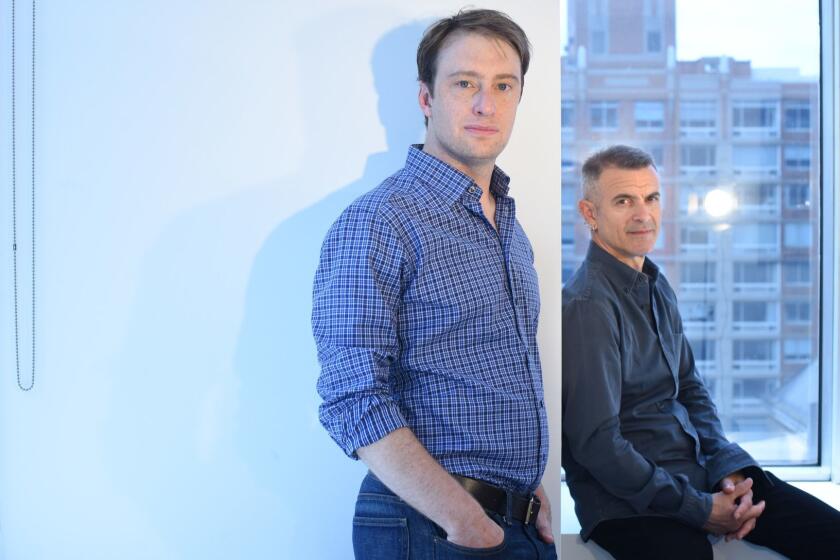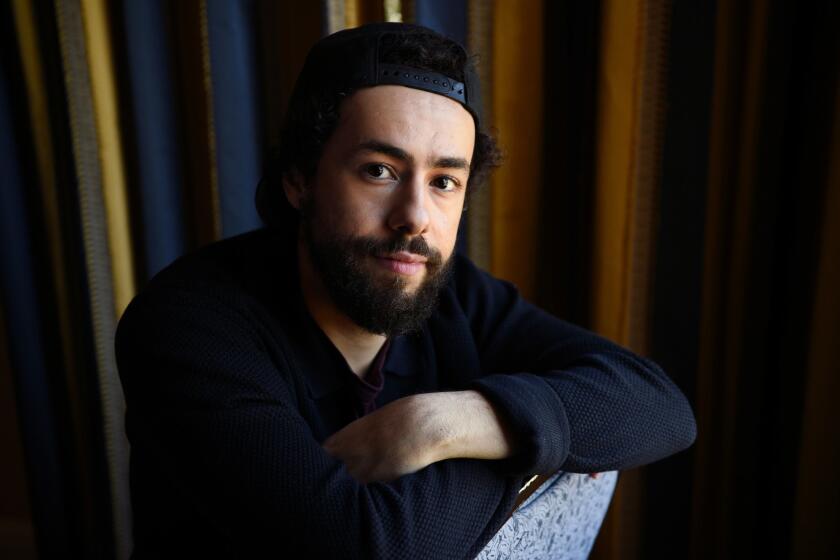9/11 is becoming part of history. Want proof? Turn on your TV
- Share via
Shock. Confusion. Panic. Fear. Anger.
These were just some of the emotions that crashed in nauseating waves over many who watched as terrorists inflicted horror and devastation in New York City, Washington, D.C., and Pennsylvania on Sept. 11, 2001.
But lately, television audiences can associate another feeling with the national tragedy: déjà vu.
Recent years have seen a variety of TV shows use footage of the attacks as story elements to support character development, set the scene or re-create history.
For some shows, there’s almost no getting around mentioning the attacks — it’s just a matter of if and how to use the actual footage.
Showtime’s “The Loudest Voice” tells the story of late, disgraced Fox News President Roger Ailes (Russell Crowe), who was so viscerally affected by the events of 9/11 that they redefined how he and his outlet handled news coverage. The miniseries’ second episode, “2001,” sees Ailes watch the attacks on several different screens at work, his mind balancing natural human reactions — rage, shock — with a cunning sense of how to beat his rivals at covering them.
It was 2014 and Gabriel Sherman was in a funk.
“We had to walk a delicate line, because the day remains so emotional and so painful,” said “Loudest Voice” showrunner Alex Metcalf, who also wrote the episode. The show filmed in New York City and included crew members who had been in the Fox newsroom on Sept. 11, as well as people who had lost friends and relatives in the attacks.
The footage that ended up running in the episode was added in post-production, but that made the subject matter no less troubling — particularly the depiction of Ailes’ decision to show people jumping from the crumbling World Trade Center towers.
“We have one shot of one jumper, that’s it,” Metcalf said. They opted not to go beyond that because it would take viewers out of the story and because “it was just brutal and emotional, honestly.”
“As a human being, it didn’t make sense to use that footage,” he said.
There was also the matter of what they had license to show. According to Metcalf, the Fox newsroom had a lot of unaired footage that was later confiscated by the FBI.
Of course, few people watching this all unfold were in the position of overseeing newsrooms on Sept. 11, making snap judgment calls on imagery that would forever alter the nature of broadcast journalism. Most Americans were scared and confused, worried about the safety of themselves and their families while not knowing whether they would be able to protect them.
This can be seen in the fourth episode of the Netflix miniseries “When They See Us.” There, Korey Wise (Jharrel Jerome), one of the teens wrongfully convicted in the Central Park jogger case, watches devastation and chaos plague a city that turned its back on him as he sits helpless in front of a prison’s television screen.
It can also be seen in “Strawberries,” the fourth episode of “Ramy,” comedian Ramy Youssef’s semi-autobiographical Hulu series about a first-generation Muslim American millennial. The episode flashes back to the lead character as an adolescent (portrayed by Elisha Henig), who is already having enough trouble fitting in before the terrorist attacks make him even more isolated at his New Jersey middle school. Footage of the smoking towers is seen only briefly, for establishing purposes, on the screen of his classroom. But it effectively sends the message that this is a defining moment for the show’s protagonist.
“It was the footage that I remembered,” said Youssef, who wrote and directed the episode. “I remember seeing it on a screen through a classroom as I was walking through the hallway… and remember how weird it felt.”
He and the show’s other producers wanted to “lean into how horrific the cinema of it was for kids,” he said.
Youssef’s show is, ultimately, meant to be comedic. But he said this meant they had to respect “the gravity of the situation and [make] sure the comedy is grounded around our main character’s paranoia and fear.”
Sex outside of marriage. Sex inside of cars. Sex as a 24-7 preoccupation.
Some may argue that using any footage from Sept. 11 is an attempt to capitalize on suffering. On the other hand, such images can also serve as quick shorthand for viewers, suggesting the tone, the subject matter or simply the place and time of the show they’re watching.
That’s the way it’s used in the early minutes of HBO’s “Euphoria,” as Zendaya’s Rue Bennett narrates that she was born “three days after 9/11” while a plane crashes into one of the towers. Neither “Euphoria” creator Sam Levinson nor Augustine Frizzell, the episode’s director, was made available for comment, but audiences’ predominant fixation on the show’s depictions of sex and drugs suggests that such imagery, used judiciously, is now merely a blip on the television’s scandal Richter scale.
Still, “One Day at a Time” creators Mike Royce and Gloria Calderon Kellett took extra precautions when they featured a flashback episode centered on the attacks during the second season of their family comedy, which at the time streamed on Netflix and has since moved to Pop. Although the episode used only audio of journalist Katie Couric sharing the news on NBC’s “Today,” “One Day at a Time” is filmed in front of a live audience, and producers posted warning signs that the content might be triggering to some viewers.
“We didn’t want to exploit it,” Calderon Kellett said of the episode. She added that, especially since so many of the show’s fans are veterans, “we didn’t want to explain what was happening — the sort of violence and attack of it all. We thought that would be harsher.”
There was a time when TV creators were far more cautious about alluding to 9/11. HBO’s “The Sopranos” eliminated the twin towers from its opening credits sequence starting with its 2002 season. MTV, which was in the midst of running a New York-set season of “The Real World” when the attacks occurred, chose to continue showing those episodes, with a message explaining that the decision was a “testament to the longstanding history and spirit of this great city.”
But the evolution of both the medium of television and public perception of the attacks themselves now makes 9/11 unique compared to other national tragedies.
David Bushman, senior curator for the Paley Center for Media, said he’s unsure of the first scripted series to show actual footage of the Hindenburg disaster or Abraham Zapruder’s video of the John F. Kennedy assassination. But he said that “in the 1960s and ’70s, before network television became inundated with competition... that would have been the last thing that TV would have done.”
“Their whole intent was to not remind you of what was going on in the real world and not to antagonize any advertisers that they had or any affiliates,” Bushman said.
He noted that it wasn’t until the ’70s, with “The Mary Tyler Moore Show” and the sitcoms of Norman Lear and Bud Yorkin, that discussion of controversial issues became a commonplace on TV. He cites the famous “Chuckles Bites the Dust” episode of “The Mary Tyler Moore Show,” which opened the door for sitcoms to talk about death. Eventually, viewers would have dramas like NBC’s “Quantum Leap,” which featured a two-part episode about the Kennedy assassination, and AMC’s “Mad Men,” in which characters view footage of Jack Ruby killing Lee Harvey Oswald and Thich Quang Duc’s suicide.
So what does it say that today’s viewers have not objected in substantial numbers to programs’ use of Sept. 11 footage?
Sanam Hafeez, a New York City-based clinical psychologist who works with PTSD patients, said the influx of smartphones — which allow us to easily document events — and the seemingly never-ending cycle of traumatic news on television means that “9/11, to some degree, has lost its value from the tragic standpoint for the younger generations that are not as fazed by it.”
There is also, of course, the passage of time. Like some of the teens on “Euphoria,” people born soon after Sept. 11, 2001, are beginning to reach voting age. They may know only the stories of the towers falling, the attack on the Pentagon or the fate of United Airlines Flight 93 from history lessons, news coverage around the anniversary of the attacks or their occasional appearance in pop culture.
“It’s still very emotional — I mean, it’s emotional for me — but people are ready to kind of look at it a little more analytically or a little more critically,” Youssef said. “We’re kind of entering the space where people want to look at it from other angles and want to discuss it in a way that I don’t think was exactly the same five or 10 years ago.”
More to Read
The complete guide to home viewing
Get Screen Gab for everything about the TV shows and streaming movies everyone’s talking about.
You may occasionally receive promotional content from the Los Angeles Times.








